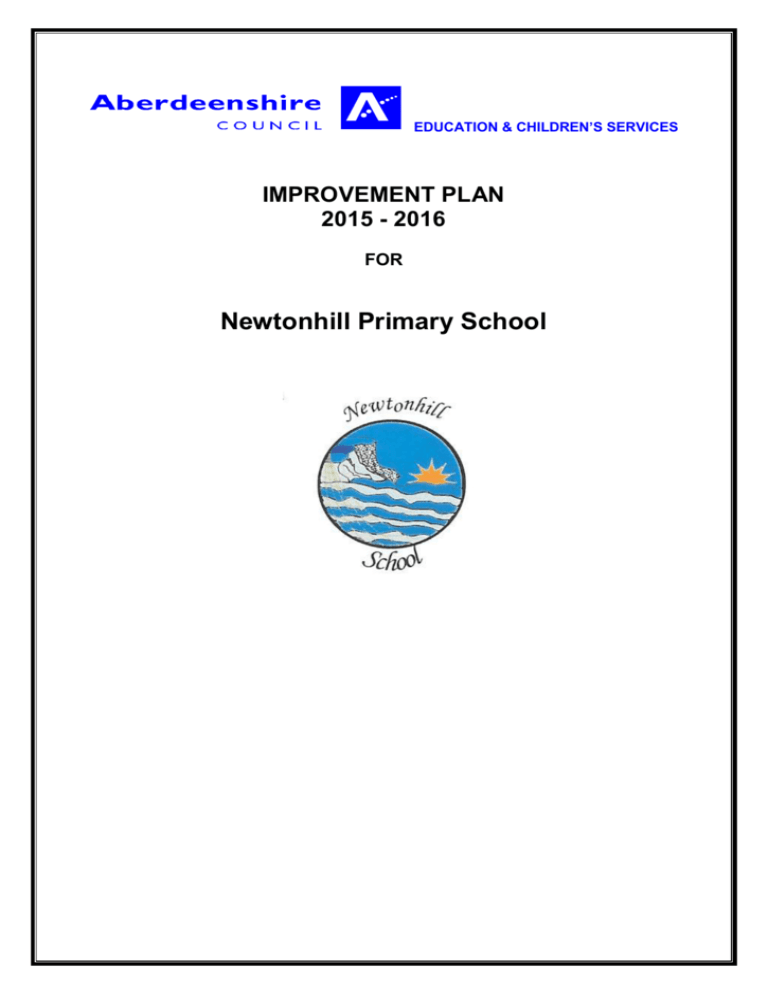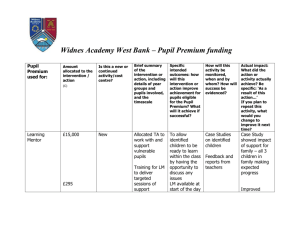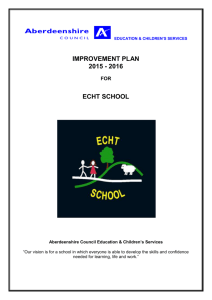EDUCATION, LEARNING & LEISURE
advertisement

EDUCATION & CHILDREN’S SERVICES IMPROVEMENT PLAN 2015 - 2016 FOR Newtonhill Primary School Aberdeenshire Council Education & Children’s Services “Our vision is for an Aberdeenshire in which everyone is able to develop the skills and confidence needed for learning, life and work.” Newtonhill School Vision Statement In Newtonhill School we aim to provide an enjoyable, quality educational experience for all pupils. We believe that growth and development of all pupils should be nurtured and encouraged and that success in all areas of life should be celebrated. Efficient education is the result of successful partnerships between home and school. Together we can ensure that your child’s experience in Newtonhill School is both productive and enjoyable. Our school motto is: RESPECT FOR ALL Our focus values are intrinsic to all we do in and out of school. These seven values are the key aspects highlighted within our school. R Responsibility E Excellence S Sense of belonging P Partnerships E Equality & Fairness C Confidence T Trust In Newtonhill Primary School our vision is the driving force behind all our improvement activity. Education & Children’s Service’s Quality Improvement Framework, is the overarching strategic management tool which directs and supports school improvement in establishments across Aberdeenshire. At the heart of the framework is the belief that self evaluation in each school drives improvement and all improvement is aimed at delivering positive outcomes for children and young people. “Self evaluation is a reflective, professional process through which schools get to know themselves well…Improvement Planning builds on that self knowledge by involving us in understanding and valuing the best of that which already exists, deciding how good we can really be, and identifying the best way forward. The Journey to Excellence Part 4: Planning for Excellence, HMIe, 2007 Self-evaluation is an on-going process and involves all stakeholders, including our pupils. It is reported annually to parents/carers in our Standards and Quality Report. Education & Children’s Service Improvement Cycle Self evaluation to find out where you have to go Review/ Re-affirm vision Identify priorities and specify outcomes Self evaluation to ensure stakeholders commitment Self evaluation to determine impact Check to ensure impact Take action Self evaluation to monitor and determine progress The priorities for improvement contained in the Improvement Plan for 2014 – 15 reflect this process and the priorities identified locally and nationally. Page 3 of 9 Improvement Plan Improvement Priority No. 2 1+2 Modern languages Intended Outcome (s) / Impact Actions / Lead member of staff Timescales Identify and agree L2 at cluster level Meet with cluster primary colleagues to determine current provision in primary and establish the L2 or L2s which can be carried forward and offered to the end of BGE in secondary. Gather stakeholder views regarding L2 possibilities this will include audit of staff ability and CLPL needs Decision taken at cluster level Communicate decision to all stakeholders Dec 2015 Parents aware of implementation of 1+2 Policy as national April 2016 Awareness raising at curricular open days Distribute parent leaflet Updates through newsletters Develop a whole school approach to modern languages Use audit toolkit to evaluate current provision in school and at cluster level Agree how languages can be incorporated into assembly programme, daily routines, school events Identify school lead for participation on cluster working group Staff developing an understanding of how they can engage with L2 Include discussion about CLPL needs as part of PRD process. Facilitate staff attendance at authority training events June 2016 How will you measure success? Audit tool, collegiate meetings Professional Discussion and classroom monitoring Planning documents Stakeholder feedback Progress Check / Comments / Next Steps Date: Page 4 of 9 Improvement Plan Improvement Priority No. 3 Restorative Approaches Intended Outcome Actions Identify and establish a training team at Cluster level B Familiarisation with resources to be used for training and planning of ‘RA Facilitator’ event and February in-service. Collegiate session introducing the principles of RA and Aberdeenshire’s vision for RA. (led by Christina Gillies –PT) All teaching and support staff within the Portlethen network attend RA day. Portlethen Network Steering Group to deliver this training. ALDO training available to support Steering Group with delivery. Education Scotland 2 day ‘Train the Trainers’ event attended by further teacher representatives from Portlethen Cluster. Training day organised. Recommend suitable resources to support practice in this area. Glow Group where resources such as video links, book lists, activity ideas are stored (incl. details of shared resources and their locations). RA Facilitator Event Event attended by at least 1 member from each Portlethen Network school. RA Facilitator) Increased parental and pupil awareness Continue to raise awareness amongst staff, parents and other interested parties. Awareness raising of RA with class teachers and SMT All teaching and support staff within the Portlethen network attend RA day. ALDO training also available. Monitor implementation of RP to establish implementation at individual school/ cluster level and make changes as required. Work with a group of pupils to create videos that can be used to show RA scenarios and pupils’ views on the change of approaches. Use lesson plans and resources to work towards the creation of an event where pupils act out (or videos are shown) which explain how RA work, RA posters on display. Develop a suitable leaflet explains RA in Newtonhill Timescales October 2015 November 2015 set up December 2015 January 2016 February 2016 March 2016 How will you measure success? Feedback from basic training, train the trainers training , trainers refresh meetings, parents / pupils / staff/ HMIE Uptake of ALDO training and feedback Audit of impact Observations Pupil, staff and parent comments and discussions . Page 5 of 9 Improvement Plan Progress Check / Comments / Next Steps Date: Page 6 of 9 Improvement Plan Improvement Priority No. 1 Curriculum Intended Outcome Actions Literacy Spelling and writing Develop a new programme for learning and teaching in spelling which encompasses progression and continuity Develop tracking and monitoring Build on existing good practice to further improve practice to enhance each learner’s experience. Increased attainment and achievement. Literacy Devise a spelling and writing programme to be used throughout the school to ensure appropriate progression and writing challenge for all pupils whilst still allowing for individual professional teaching style and approach. Develop tracking and monitoring to be used at all stages to track attainment. Audit existing resources. Parents/Carers aware of expectation of achievement and challenge for all children. Timescales Spelling august – November Writing December –March Ongoing Assessment/Tracking/Monitoring Review information from INCAS and use to inform need and develop priorities Review SWST Research maths assessment to support school progress and assessment/achievement. Profiling and the Profile (P7) Agree and improve format of TMR across all levels Dyslexia Friendly Classroom Develop and improve dyslexia support across all classes Support all pupils with dyslexia Provide accessible resources to support dyslexia Assessment/Tracking/Monitoring Pupils assessed in line with Authorities timeline Analysis of CE feedback and reports Use of information in approaches to learning and teaching. Agree a Primary 7 pupil profile format in discussion with academy Adapt and develop format throughout school Assess targeted pupils for dyslexia Use dyslexia overlay kit to assess for suitable colour overlays for individual pupils Provide resources and training for Dyslexia Friendly Classrooms Use Educational Psychologists new support material (available November?) Intended Outcome Actions December 2015 June 2016 Timescales Page 7 of 9 Improvement Plan Numeracy Further develop a programme for learning and teaching in numeracy which encompasses progression and continuity Develop tracking and monitoring in line with Aberdeenshire Progression Frameworks Build on existing good practice to further improve practice and enhance each learner’s experience. Increased attainment and achievement. Audit and review methods of teaching for numeracy Take guidance from numeracy development group Audit and review current resources Make parents/carers aware of numeracy developments and share methodologies Compare data and begin to monitor improvements to take forward into 2016/2017 March to July 2016 How will you measure success? • An improved and agreed progression for spelling, writing and numeracy. • Professional discussion • Improved learning and teaching • Classroom observations • Raised attainment • Improved TMR Page 8 of 9 Improvement Plan Procedures in place to enable effective Tracking and Monitoring of pupil progress. Pupil achievement recorded and shared with parents Profiling and profile data and information used to support transition at all stages. ~~~~~~~~~~~~~~~~~~~~~~~~~~~~~~~~~~~~~~~~~~~~~~~~~~~~~~~~~~~~~~~~~~~~~~~~~~~~~~~~~~~~~~~~~~~~~~~~~~~~~~~ Standardised Assessments Annual completion of assessments and reports produced by CEM Information used to inform T, M & R procedures and processes. Tracking, Monitoring and reporting through SEEMIS. Tracking and Monitoring systems and procedures in place All staff able to access SEEMIS to record evidence of progress ~~~~~~~~~~~~~~~~~~~~~~~~~~~~~~~~~~~~~~~~~~~~~~~~~~~~~~~~~~~~~~~~~~~~~~~~~~~~~~~~~~~~~~~~~~~~~~~~~~~~~~~~ Classrooms addressing and supporting the children with dyslexia Accessible resources for all pupils Raised awareness Strategies implemented by all teachers Parents involved in strategies being used to support Dyslexia Progress Check / Comments / Next Steps Date: Date Page 9 of 9








![afl_mat[1]](http://s2.studylib.net/store/data/005387843_1-8371eaaba182de7da429cb4369cd28fc-300x300.png)